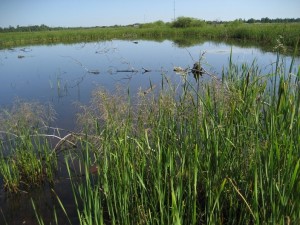The Clean Water Act requires regulatory agencies to make difficult choices about exactly where “water ends and land begins.”[1] Whether a particular property contains “waters of the United States,” the touchstone for federal jurisdiction under the Act,[2] is not easy to determine, especially when the question involves not traditionally navigable waters but wetlands.  The Environmental Protection Agency defines “wetlands” as areas such as swamps, marshes, and bogs that are periodically inundated with water. Severe consequences flow from unpermitted actions that impact “waters of the United States.” The Act imposes criminal liability and civil penalties to the tune of $37,500 per day of violation.[3] Upon request, the Army Corps of Engineers will issue jurisdictional determinations (“JDs”) specifying whether a particular property contains jurisdictional waters. In recent years, the Supreme Court has wrestled with various aspects of wetlands issues again and again and again and again. The most recent such case, United States Army Corps of Engineers v. Hawkes Co., No. 15-290, raised the question of whether Corps JDs constitute “final agency action” that is immediately appealable in federal court under the Bennett v. Spear analysis rooted in the Administrative Procedure Act.
The Environmental Protection Agency defines “wetlands” as areas such as swamps, marshes, and bogs that are periodically inundated with water. Severe consequences flow from unpermitted actions that impact “waters of the United States.” The Act imposes criminal liability and civil penalties to the tune of $37,500 per day of violation.[3] Upon request, the Army Corps of Engineers will issue jurisdictional determinations (“JDs”) specifying whether a particular property contains jurisdictional waters. In recent years, the Supreme Court has wrestled with various aspects of wetlands issues again and again and again and again. The most recent such case, United States Army Corps of Engineers v. Hawkes Co., No. 15-290, raised the question of whether Corps JDs constitute “final agency action” that is immediately appealable in federal court under the Bennett v. Spear analysis rooted in the Administrative Procedure Act.
Earlier this week, the Supreme Court unanimously ruled that JDs constitute final agency action and are immediately appealable. The Court quickly rejected the Corps’ two arguments to the contrary: first, the rather unreasonable suggestion that affected citizens could simply proceed without a permit, risking an enforcement action during which one could argue that no permit was required; and second, that upon receiving a “positive” JD, affected citizens could apply for a permit and seek judicial review of the JD upon the conclusion of the lengthy permitting process (the property owners in Hawkes estimated that it would cost well over $100,000 to “earn” the appeal right under that scenario).
Despite its importance, the decision is not particularly surprising given the tenor of the oral argument as well as the Court’s recent decision in Sackett v. Environmental Protection Agency, 566 U.S. — (2012) that an EPA compliance order is immediately appealable to federal court when it was based on the factual assumption that a parcel contained wetlands. Perhaps for that reason, it’s not the majority opinion that has everyone talking; instead, Justice Kennedy stole the show with a three-paragraph concurrence.
In his concurrence, Justice Kennedy wrote that an immediate appeal right was especially important given that the reach of the Act is “notoriously unclear” and subjects landowners to “crushing” consequences, “even for inadvertent violations.” Justice Kennedy described the Act’s reach as “ominous,” and wrote that it “continues to raise troubling questions regarding the Government’s power to cast doubt on the full use and enjoyment of private property throughout the Nation.”
The Hawkes concurrence is a striking contrast to Justice Kennedy’s opinion in Rapanos v. United States,[4] another wetlands case. In Rapanos, Kennedy conducted a fairly searching analysis of “the Act’s text, structure, and purpose,” and formulated a relatively broad test under which federal jurisdiction exists over any wetland or other water with a “significant nexus” to navigable waters. He wrote that “the significant-nexus test itself prevents problematic applications of the statute,” and recognized that “[i]mportant public interests are served by the Clean Water Act in general and by the protection of wetlands in particular.”
Without question, Hawkes was a defeat for the Administration. Yet the government’s far greater concern is likely that Justice Kennedy’s position in Hawkes doesn’t bode well for one of the Administration’s signature environmental achievements, the “Waters of the United States” rule, now known as the “Clean Water Rule.” That rule attempts to clarify the definition of “waters of the United States,” and by extension the scope of the Act’s coverage, to make it more predictable. Dozens of states and other petitioners have already challenged the rule in a variety of federal courts, many on the grounds that it unlawfully expands federal jurisdiction, with most such suits now consolidated in the Sixth Circuit. Most expect that case to end up before the Supreme Court, where Justice Kennedy – who just described the Act’s reach as “ominous,” “unclear,” and “troubling” – will hold a critical vote.
[1] United States v. Riverside Bayview Homes, 474 U.S. 121, 132 (1985).
[2] 33 U.S.C. §§ 1311(a), 1362(7), (12).
[3] See 33 U.S.C. § 1319; 40 CFR § 19.4.
[4] 547 U.S. 715 (2006).

Very unfortunate